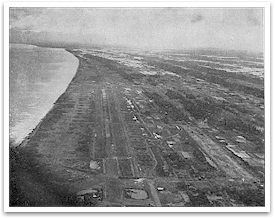Air Support Operations
While the XIV Corps and the 11th Airborne Division
required few close air support missions during their drives toward Manila,
air power assumed an important role in the operations. 53 The
511th Parachute Infantry drop is one case in point. On XIV Corps' left, air
operations attained perhaps more significance. With its left exposed, the
1st Cavalry Division depended in large measure upon air for its flank
protection. Beginning on 1 February Marine Air Groups 24 and 32, flying from
the recently completed Mangaldan strip near Lingayen Gulf, kept nine SBD's
(Douglas dive bombers) over the cavalry's leading elements. Other SBD's and
Fifth Air Force P-40's, all under 308th Bombardment Wing control, undertook
reconnaissance missions along the cavalry's left flank and left front.
During the last stages of the dash to Manila a squadron of Fifth Air Force
A-20's--medium bombers--maintained a constant ground alert at the Lingayen
fields awaiting call by either of XIV Corps' leading divisions.
The SBD's flew only one close support mission--if it can
be so designated. Near the Santa Maria River ford, on 3 February, the 1st
Cavalry Division called upon the Marine planes to disperse a small group of
Japanese holding a piece of high ground dominating the crossing point.
Unable to fire because the cavalrymen were too close to the target, the
planes made several simulated strafing attacks over the Japanese positions.
These "dry runs" so unnerved the Japanese that most of them soon fled. 54
Mindoro-based planes of the 310th Bombardment Wing
provided the support for the 11th Airborne Division. P-47's or P-38's
maintained a constant four-plane umbrella over the leading troops, and on 1
and 2 February the 310th Wing executed close support bombardment and
strafing missions at the defile west of Tagaytay Ridge.
Not all the air support missions went off without a
hitch. It might have been expected that after three years' experience
air-ground co-operation would be such as to preclude bombing and strafing
friendly troops, but the contemporary records of Sixth Army and its
components reveal that there were many such incidents, most of them
apparently attributable to pilot errors in target identification. 55
Late in January General Krueger had informed General
Kenney, the commander of the Allied Air Forces, that since the Fifth Air
Force had taken over air support responsibility on Luzon from the Allied
Naval Forces' CVE-based planes there had been "numerous incidents" of Fifth
Air Force planes attacking I and XIV Corps troops. Krueger went on to point
out that, as a result, his ground forces were rapidly losing confidence in
the supporting air arm. 56 Finally,
after another mistake by Fifth Air Force planes on 4 February caused more
casualties,57 Krueger
sent Kenney a blistering radio:
I must insist that you take effective measures to
stop the bombing and strafing of our ground forces by friendly planes. .
. . These repeated occurrences are causing ground troops to lose
confidence in air support and are adversely affecting morale. 58
General Kenney and his subordinates, having received
steadily increasing criticism from Sixth Army troops, were taking many steps
to prevent errors. It can be supposed that they now redoubled their efforts. 59
The vast majority of air strikes, whatever service
executed them, were both accurate and helpful. As the campaign on Luzon
progressed, the incidence of mistakes rapidly diminished as Fifth Air Force
pilots became more familiar with the ground situation and the Allied Air
Forces and the Sixth Army modified and improved air-ground liaison and
control systems. Although some of the Army divisions on Luzon preferred to
have Marine Corps aircraft support them, Fifth Air Force pilots, who had
previously had rather limited experience in close air support operations,
became well versed in such activity, and some of the Fifth's squadrons came
to provide as excellent close air support as was to be executed anywhere
during World War II. In the end, the Fifth Air Force did its job and did it
well.
|
|
|
|
|
|
 |
|



